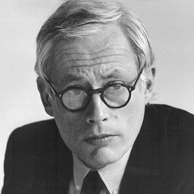
Dieter Rams
designer industriale (1932)
Dieter Rams was born in Wiesbaden in 1932, is a German industrial designer of the modern age. The goal of his work and the purpose of his projects is clarity of form, choice of materials and ease of use.
He studied architecture at the Werkkunstschule Wiesbaden and learned the art of carpentry from his father, between 1943 and 1957. After working for the architect Otto Apel, from 1953 to 1955, he joined a company producing electronic items. , Braun, of which he became director of the design department from 1961 to 1995.
His activity is closely linked to Braun and to the functionalist school of industrial design of Ulm (Hochschule für Gestaltung, ie high school of design).
His non-invasive approach and his belief in "less but better" design have generated a timeless quality in his products and have influenced the design of many products that have assured them international appreciation and recognition.
Together with the Braun staff, he makes numerous memorable products, including the famous SK-4 turntable and the D-series projector. He is also known for designing the 606 Universal Shelving System bookcase produced by Vitsœ in 1960.
Many of its products: coffee machines, calculators, radios, audiovisual equipment, office products, are exhibited in museums all over the world, including the MoMA in New York.
Dieter Rams continues to be a reference figure in the design world; he recently designed a cover for Wallpaper magazine.
The influence of Rams' design is evident in the works of Jonathan Ive, designer for Apple, in products like the iMac, the iPod, and the iPhone. For example, the iOS 6 calculator application is based on the style of the Braun ET66 designed by Rams.
Rams explains his approach to design: "Weniger, aber besser", translatable into "Less, but better".
Rams introduced the idea of ​​sustainable development and obsolescence as a crime in design in the 1970s. As a result, the question was posed: "Is my design a good design?".
The answer becomes the basis for its famous ten principles for "good design":
1) is innovative - the possibilities for progress are not, in any way, exhausted. Technological development always offers new opportunities for original designs. But imaginative design always develops in tandem with the improvement of technology and can never be an end in itself.
2) makes a useful product - A product to be used is purchased. It must satisfy not only functional, but also psychological and aesthetic criteria. Good design emphasizes the usefulness of a product, ignoring everything that could belittle it.
3) is aesthetic - The aesthetic quality of a product is an integral part of its usefulness because the products are used every day and have an effect on people and their well-being. Only well-executed objects can be beautiful.
4) makes a product understandable - Clarifies the structure of the product. Even better, it can make the product clearly express its function by making use of the user's intuition. At best, it is self-explanatory.
5) is discreet - Products that fulfill a purpose are like tools. They are neither decorative objects nor works of art. Their design should therefore be neutral and sober, to make room for the personal expression of the user.
6) is honest: it does not make a product appear more innovative, powerful or precious than it actually is. It does not attempt to manipulate the consumer with promises that can not be maintained.
7) It is enduring - It avoids being fashionable and therefore never seems antiquated. Unlike fashion design, it lasts many years - even in today's disposable society.
8) is accurate to the last detail - Nothing must be arbitrary or left to chance. Care and accuracy in the design process show respect towards the consumer.
9) is respectful of the environment - Design makes an important contribution to the protection of the environment. It conserves resources and minimizes physical and visual pollution throughout the product life cycle.
10) is the least possible design - Less, but better - because it focuses on the essential aspects, and the products are not burdened by non-essential elements. Back to purity, back to simplicity.






